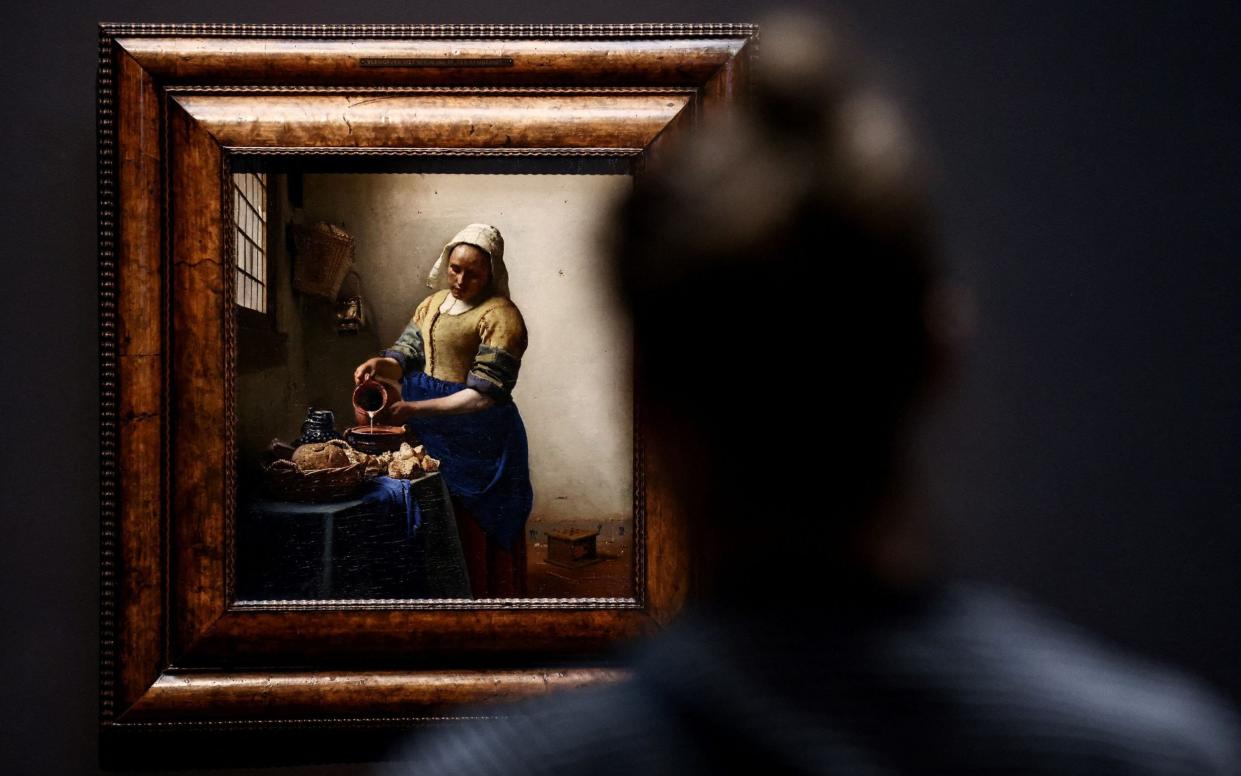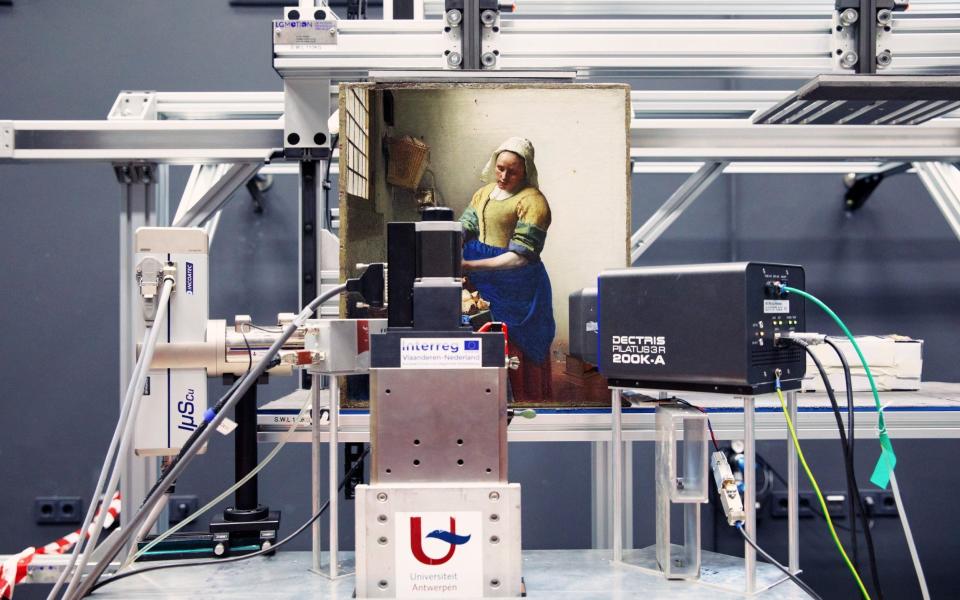What was Vermeer hiding in The Milkmaid?

Some of the world’s most-advanced technology for studying, screening and authenticating paintings can be found inside a windowless room deep inside an annexe of the Rijksmuseum. There is something of the operating theatre about it: electrical boxes, cables everywhere; white lights, the inevitable persistent hum. And it is here where scientists recently cracked one of the art world’s great mysteries.
“I took the measurements that allowed the teams and analysts to make the discovery,” says Francesca Gabrieli, the Amsterdam museum’s self-effacing research scientist, who today is showing me around. “Scientists, curators and conservators work as a team here,” she says.
For hundreds of years, experts have speculated about a faint, rectangular blotch in Johannes Vermeer’s oil painting The Milkmaid, just visible on the wall behind the meditative young woman pouring from a jug. What detail did the Dutch master paint over, and why? Was it a map? A fireplace? Something else?
Art-world scientists like Gabrieli have traditionally used infrared cameras to help answer such questions, with limited results. But with the laboratory’s advanced Reflectance Imaging Spectroscopy (RIS) technology, the Amsterdam team took hundreds of images in the entire spectral range of The Milkmaid to produce a “false-colour image” – essentially a digital version of the painting, which broke down the chemical composition of Vermeer’s pigments and highlighted the differences. That revealed far more about what lay beneath one of the world’s most enigmatic paintings than what could previously be seen.
Working partly in the laboratory, which was founded just four years ago with technology used by Nasa for photographing space, the team discovered neither map nor fireplace, but a jug-shelf – a common decorative feature in 17th-century Dutch houses, now largely forgotten. “One of the curators recognised it from a similar shelf in a 17th-century dolls house in the Rijksmuseum collection,” says Ige Verslype, a Rijksmuseum conservator, as she inspects high-definition scans on a computer screen in her studio, where dozens of old masters undergoing restoration are resting on easels.

Why did Vermeer obliterate it? “We don’t know, perhaps it was a distraction,” says Verslype. “Now, all our attention is on the milkmaid’s face, her intense concentration. And what becomes clear is how he developed his composition.” Such details seem insignificant. But Vermeer’s edits enhance our understanding of his genius, and the techniques that allowed him to achieve the supernatural stillness that permeates his scenes of domestic life in 17th century Delft. (Vermeer was even more ruthless and experimental with The Little Street, obliterating the figure of a woman and adding children at play.)
These and other revelations from the Rijksmuseum’s experts explain much of the excitement surrounding Vermeer, the museum’s first exhibition dedicated to the Dutch master’s work, which opens this month. It will be the biggest Vermeer exhibition anywhere, ever.
Vermeer (1632-1675) is due a reckoning in his homeland. When the Rijksmuseum, the Netherlands’ vast and extravagant national gallery, opened in 1885, he was not even among the artists immortalised in its Gallery of Honour. Finding Vermeer’s name on the exterior is still a struggle: it is on a lunette on the west side, far from those of the other Dutch masters.
Yet Vermeer is the Rijksmuseum’s fastest-selling exhibition, with presales of more than 100,000 tickets by mid-January. The show, which brings together for the first time 28 of the 37 paintings that remain from his oeuvre, is on every must-see list for 2023. (The remaining nine paintings were too fragile to travel).

Highlights include the newly restored Girl Reading a Letter at an Open Window on loan from the Gemäldegalerie Alte Meister in Dresden; all three from the Frick collection in New York, including Girl Interrupted at Her Music; two from the National Gallery in London and his masterpiece, Girl with a Pearl Earring, on loan from Mauritshuis in The Hague.
“We have wanted to do this for decades,” says Pieter Roelofs, the Rijksmuseum’s head of paintings and sculpture. “We always thought it was our responsibility. But we also thought it was impossible.”
The Rijksmuseum’s scientists and conservators plan investigative screening on the visiting paintings, where they have permission to do so. RIS is non-invasive, meaning samples of paint no longer have to be removed for chemical analysis. The last Vermeer show was in 1995 at the National Gallery of Art in Washington (“almost legendary,” says Roelofs), which gathered about 20 paintings. “That means no one under 40 has had the opportunity to see a Vermeer exhibition before,” he says. “And I’m convinced we will never see one like this again.”
This time, the catalyst was the renovation of the Frick, which owns three Vermeers that, according to protocols, cannot leave its custody at the same time. But when the New York gallery moved to a temporary site on Madison Avenue in 2020 while its East 70th Street premises were upgraded, Roelofs saw an opportunity, and asked again. The Frick’s board approved an unprecedented loan to the Rijksmuseum, and once the Frick had agreed to lend its Vermeers, other major collections followed.
Vermeer’s appeal to modern eyes lies in a certain ineffability, says Taco Dibbits, the Rijksmuseum’s director. “You’re left speechless, words are not enough. They radiate tranquillity and intensity. But it’s always been difficult to pinpoint what makes him a genius.”
But the revelations are not just technological. Historians, too, have cast light on the spirituality that infuses Vermeer's paintings, and the reasons why he painted them, to coincide with the exhibition. For 150 years, Vermeer has been the “Sphinx of Delft”, a term coined by the French art critic Théophile Thoré-Bürger in an 1866 essay for the Gazette des Beaux Arts. Although we know Vermeer lived and worked in the city, little evidence from his life survives: no diaries, no correspondence, very few records.

That characterisation revived his popularity, but it also clung to him: he was a riddle, an introverted Calvinist, devoted to painting placid, secular scenes from domestic life. Before Thoré-Bürger, Vermeer was nearly forgotten, which explains his omission from the Rijksmuseum’s Gallery of Honour, assembled the year before the essay was written.
Now, fresh insights into Vermeer’s religious life in a new book by Gregor Weber, the Rijksmuseum’s head of fine art, changes our understanding all over again. In Vermeer: Faith, Light and Reflection, published last month, Weber shows that the protestant painter’s 1653 marriage to a Catholic, Catharina Bolnes, means he possibly converted. Weber posits that some paintings were less domestic studies and more moral lessons, possibly for his growing children. One example is Woman with a Pearl Necklace, which will be in Amsterdam on loan from the Gemäldegalerie in Berlin. “He’s saying, focus on piety instead of your jewellery, and a 17th century viewer would have understood that immediately,” says Roelofs.
Beyond the revelations by scientists and historians lies Vermeer’s extraordinary stillness. Standing in front of The Little Street, now firmly in the Rijksmuseum’s Gallery of Honour, Vermeer’s study of redbrick Delft houses and their occupants is something akin to entering another dimension. His subjects are caught up in intimate, ephemeral moments: sewing, washing, playing. Their costumes may be 350 years old, but they are instantly familiar. The cobbled streets and cracked paintwork that surround them are almost tactile.
Another reason for Vermeer’s enduring appeal becomes clear: Vermeer may have painted Delft scenes from 350 years ago, but his work is about ordinary people. It is about us, and in many ways, Vermeer is no mystery at all. Frederick Sommer, the American artist, said “the art of Vermeer must have been there on the morning of creation”, which is perhaps the closest anyone has come to describing his genius.
“We have always been standing over his shoulder,” says Dibbits. “Only now, technology has allowed us to stand closer.”
Vermeer is at the Rijksmuseum, Amsterdam, from February 10 until June 4. Info: rijksmuseum.nl

 Yahoo Movies
Yahoo Movies 
